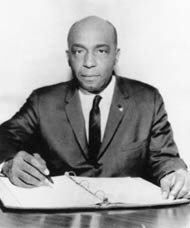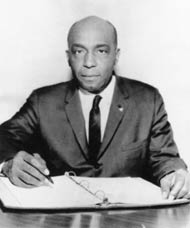

Samuel Wilbert Tucker (June 18, 1913 – October 19, 1990) was an American lawyer and a cooperating attorney with the National Association for the Advancement of Colored People (NAACP). As a founding partner in the Richmond, Virginia firm of Hill, Tucker and Marsh, he is best remembered for one of his several civil rights cases before the Supreme Court of the United States: Green v. County School Board of New Kent County which, according to The Encyclopedia of Civil Rights In America, “did more to advance school integration than any other Supreme Court decision since Brown.” He is also remembered for organizing a 1939 sit-in at the then-segregated Alexandria, Virginia public library.
Tucker was born in Alexandria, Virginia on June 18, 1913. His father, a real estate agent and NAACP member, and teacher mother saw to his formal and informal education. Tucker began drafting deeds to help his father at an early age, and also began reading the law books of Tom Watson, a lawyer who shared an office with the senior Tucker.
Samuel attended Howard University whose chaplain Howard Thurman had become an outspoken proponent of Mahatma Gandhi’s nonviolent resistance strategy and where Charles Houston established the nation’s first program in civil rights law. He earned his undergraduate degree in 1933. Tucker soon qualified for the Virginia bar exam based on his studies in Watson’s law office, but had to wait til June 1934, when he reached age 21, to begin practicing law. After two years with the Civilian Conservation Corps, Tucker and his friend George Wilson (a retired Army sergeant) began in earnest dismantling segregation in Alexandria, first at the public library opened just 2 blocks from his home in August 1937, but which refused to issue cards to black residents.
In 1939, Tucker organized a sit-in at Alexandria’s public library, which refused to issue library cards to black residents. On August 21, five young black men whom Tucker had recruited and instructed – William Evans, Otto L. Tucker, Edward Gaddis, Morris Murray, and Clarence Strange – entered the library one by one, requested applications for library cards and, when refused, each one took a book off the shelf and sat down in the reading room until they were removed by the police. Tucker had instructed the men to dress well, speak politely and offer no resistance to the police so as to minimize the chance of the men being found guilty of disorderly conduct or resisting arrest. Tucker defended the men in the ensuing legal actions which resulted in the protesters not being convicted of disorderly conduct and in a branch library being established for blacks. While the sit-in received a four paragraph story in the local Alexandria Gazette newspaper and brief mention in the Washington Post, the Chicago Defender ran the story on its front page accompanied by a photograph of the arrest, noting that the protest was being viewed as a “test case” in Virginia.
World War II interrupted his practice and Tucker entered the Army, serving in the 366th Infantry in combat in Italy and rising to the rank of major. After the war, Tucker moved his law practice to Emporia, Virginia. During the 1960’s he joined Oliver Hill and Henry L. Marsh III to form the law firm Hill, Tucker & Marsh in Richmond, Virginia. As the black civil rights struggle developed during the postwar era, Tucker played a central role in its legal battles in Virginia. From 1960 to 1962, the Virginia State Bar repeatedly attempted to disbar Tucker by alleging unprofessional conduct related to cases Tucker pursued on behalf of the NAACP. The NAACP rallied to his defense in fighting what it viewed as an attempt to derail legal desegregation in Virginia and the case was repeatedly dismissed/non-suited.
Tucker was the principal lawyer for the National Association for the Advancement of Colored People in a number of post-Brown school desegregation cases. He participated in the long legal struggle to reopen the public schools in Prince Edward County, Virginia, closed by the county to avoid desegregation. Tucker also participated in the lawsuit that ended the state tuition grant program that allowed white children to attend segregated academies at public expense and was involved in cases that challenged the death penalty as being racially biased. He fought against racial discrimination in jury selection. In 1967, for example, he had about 150 civil rights cases before state and federal courts.
Tucker’s greatest legal achievement was probably Green v. County School Board of New Kent County, which challenged a freedom-of-choice plan the board had enacted to desegregate the county schools on a voluntary basis. The case went to the Supreme Court of the United States, which ruled in May 1968 that the freedom-of-choice plan was an inadequate remedy. The justices determined that school boards had an “affirmative duty” to desegregate their schools.
The NAACP Legal Defense and Educational Fund named him lawyer of the year in 1966. In addition to bringing cases, Tucker was also active in the leadership of the NAACP, serving as chairman of the legal staff of the Virginia State Conference and representing Virginia, Maryland and the District of Columbia on the National Board of Directors. In 1976, the NAACP honored Tucker by awarding him the William Robert Ming Advocacy Award for the spirit of financial and personal sacrifice displayed in his legal work.
Tucker died on October 19, 1990. He is buried in Arlington National Cemetery. In 1998, Emporia, Virginia dedicated a monument in his honor. The monument’s inscription called Tucker “an effective, unrelenting advocate for freedom, equality and human dignity – principles he loved – things that matter.”
